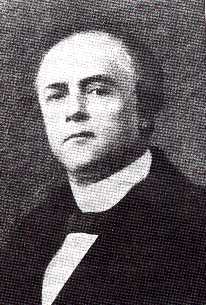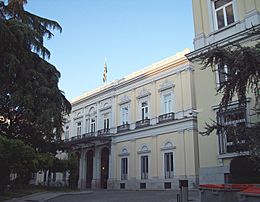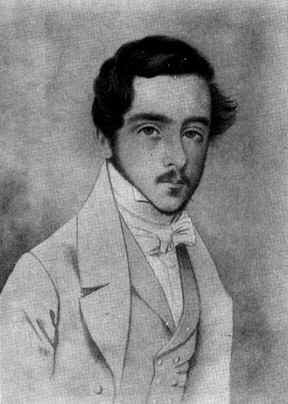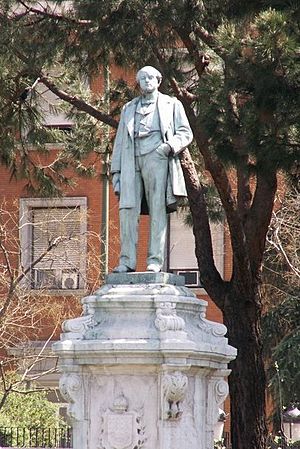José de Salamanca, Marquis of Salamanca facts for kids
Quick facts for kids José de Salamanca |
|||||
|---|---|---|---|---|---|
| 1st Marquess of Salamanca, 1st Count of los Llanos | |||||
 |
|||||
| Born | 23 May 1811 Málaga, Spain |
||||
| Died | 21 January 1883 Carabanchel Bajo, Spain |
||||
| Wife |
|
||||
|
|||||
José de Salamanca y Mayol (born May 23, 1811 – died January 21, 1883) was an important Spanish nobleman, politician, and businessman. He held the titles of 1st Marquess of Salamanca and Grandee of Spain. He even served as Spain's Finance Minister and was briefly like a prime minister in 1847.
José de Salamanca was very influential during the time of Queen Isabella II. He is famous for expanding the city of Madrid, and a neighborhood there, Salamanca, is named after him. He lived an exciting life with many ups and downs. At one point, he was probably the richest person in Spain. He worked with powerful people, including Maria Christina of the Two Sicilies, who was the queen mother and regent for young Queen Isabella. As a businessman, he started many projects that helped shape modern Spain, like building railways, creating new neighborhoods, and working in banking.
Contents
Early Life and First Steps in Politics
José de Salamanca studied philosophy and law in Granada, finishing his education in 1828. In Granada, he likely met groups who were against the absolute rule of King Ferdinand VII. This included Mariana Pineda, who became a hero for Spanish liberals.
Soon after returning to his hometown of Málaga, a liberal general named José María Torrijos was arrested for trying to start a rebellion. Salamanca was probably involved in this attempt. He went to Madrid to try and get a royal pardon for Torrijos, but he was not successful.
After this, his strong political feelings calmed down for a while. Thanks to his father's friendship with Francisco Cea Bermúdez, who was effectively the prime minister, Salamanca became the mayor of Monòver in 1833.
That same year, King Ferdinand VII died. His wife, Maria Christina, became regent for their three-year-old daughter, Queen Isabella II. The political changes during this time helped Salamanca rise in national importance. In 1835, he was named mayor of Vera. While there, he married Petronila Livermore y Salas. After being mayor of Vera, he was chosen to represent the province of Almería in the Revolutionary Government in Seville.
In 1837, a military uprising forced Maria Christina to bring back the liberal Constitution of 1812. This led to the new Progressive Constitution of 1837. Salamanca was elected as a representative for Málaga in the new parliament. This brought him to the capital city, Madrid, to serve in this important role.
Rising in Politics and Business
Once in Madrid, Salamanca became very interested in business. This led to both huge successes and big challenges for him. After a short time as a judge, in 1839 he got the official right to control the salt trade. He also started investing in the Bolsa de Madrid (Madrid Stock Exchange). He quickly became a well-known figure in Madrid's highest social circles.
Over the next few years, he worked with many important people. These included bankers like Nazario Carriquiri and agents for the Rothschilds. However, his control of the salt trade also made him an enemy of General Ramón María Narváez for a time.
Besides his business ventures, his political career also grew. On March 28, 1847, he was named Finance Minister of Spain. When that government fell in October of the same year, he briefly became the acting prime minister. However, he was soon replaced as parliament began looking into some financial issues during his time as minister.
Salamanca had faced some tough times with his stock investments. Queen Isabella II made him Finance Minister, which helped him out. But the Queen soon replaced the entire government, bringing General Narváez back as prime minister. As Salamanca's favors to his friends became known, he started working with generals who were planning to overthrow the government. When Narváez became powerful again, Salamanca had to go into exile in France, where he stayed until 1849.
Five years later, he was in exile again. He was called a "black beast" by the new Progressive government that came to power in 1854. This government ended a period called the década moderada and started the bienio progresista.
There was a group that took advantage of all business opportunities, even if the country suffered. Led by [Maria] Christina and her manager Salamanca, who was seen as very immoral. To get into the Spanish railway business and attack it like hungry wolves was something no one admired, because it was not admirable.
—La Ilustración (newspaper), July 24, 1854, when Salamanca was in exile.
Long before this Progressive period ended, Salamanca was back in Spain. In 1856, when the Moderates regained power, Salamanca was back in favor. He was given the important title of senator for life.
A Major Businessman

During his 42 years in Madrid, Salamanca had a huge career as a financier and businessman. This is what he is most remembered for. He helped start the Bank of Isabella II in 1844 and the Bank de Cádiz in 1846. After returning from his first exile, he made a lot of money, almost 300 million reales, by renting out the state salt monopoly for five years. This was twice what he had earned before. He also improved his relationship with Narváez. Narváez and Agustín Fernando Muñoz, Duke of Riánsares (who was the queen mother Maria Christina's second husband) became his partners in many business projects.
Salamanca is known for developing the Madrid neighborhood that was named after him. This was the first part of a plan to expand Madrid. One of his last business projects was a similar expansion in San Sebastián in 1881.
Investing in Railways
Salamanca also put a lot of money into railways. He started building the line from Madrid to Aranjuez. On December 24, 1845, the Madrid-Aranjuez Railway Company was created with a lot of capital. His partners this time were the banker Nazario Carriquiri and the Count of Retamoso, who was Maria Christina's brother-in-law.
Building this railway line caused Salamanca some financial problems. It happened at the same time as a financial crisis in 1846. Also, his Bank of Isabella II had problems, and he fell out of favor, leading to 16 months of exile in France.
Despite the difficulties, the railway line was successfully completed and started running on February 7, 1851. Queen Isabella II attended the opening, and over a thousand guests enjoyed a big party paid for by Salamanca himself. Three months later, the line was earning 50,000 reales every day. On August 13, 1852, Salamanca sold the line to the state for 60.2 million reales, then rented it back for 1,500,000 reales a year.
Today, that route is part of a larger line from Madrid to Alcázar de San Juan. A special Sunday tourist train, the Tren de la Fresa ("Strawberry Train"), still uses the nickname the Madrid-Aranjuez line earned in its early days.
Salamanca also invested in other railways, including lines from Madrid to Irún, and from Córdoba to Málaga. His investments weren't just in Spain. They reached across Europe and even to the Americas, including the Atlantic and Great Western Railroad in New York State. This is why the small city of Salamanca in western New York and its surrounding township are named after him.
Controversial Business Moves
In autumn 1844, the Bolsa de Madrid (Spain's largest stock exchange) was doing very well. People were optimistic because the government seemed stable. However, after some analysis, Salamanca started selling stocks in a way that seemed unusual.
Using his knowledge of public affairs, Salamanca knew that some generals were thinking about a coup. He also knew that Narváez was trying to get them to stop their plan.
When news arrived that General Martín Zurbano had started a rebellion, Salamanca and his partners announced it to cause panic. The stock exchange, which reacts quickly to big changes, dropped sharply. Salamanca made about 30 million reales in a single day. Fernando Muñoz and General Narváez each received 2 million.
(...) It is very "salty", and although I was much enraged, I am weak, I want ... but do not say it because then I come to propose a business where we're going to give Spain many millions.
Where the law has most failed is on the routes that have been granted to Señor Salamanca, and the reason is because this man is associated with a powerful man who has too much and too fatal an influence on the matter.
Challenges with the Bank of Isabella II
The 1844 stock market event was controversial, but the Bank of Isabella II is considered a major issue in Salamanca's reputation. The bank was his idea, and he convinced the queen to create it. Founded in 1844, it was meant to be a very important financial institution. It started with a lot of money, which it lent generously to Spain's new investors.
The bank never became a big financial success. Salamanca used its money for his own purchases, like buying a large piece of land from María Luisa de Borbón. He paid for it with a check from the bank. When it was time for the check to be paid, Salamanca turned to Queen Isabella, who owed money to the bank. However, she insisted on paying her debt with her shares in the Madrid-Aranjuez railway. These shares, which she had paid 4 million reales for, were almost worthless by then.
The bank was eventually saved by being combined with the Bank of San Fernando. This merger formed the basis for what is now the Bank of Spain.
Later Years and Legacy
From 1860 onwards, Salamanca's business career started to slow down due to several projects that didn't succeed. He was already past his richest years when the queen made him Marquess of Salamanca in 1863 and Count of los Llanos in 1864. This last title made him a Grandee of Spain, a very high noble rank. Not long after this, he had to sell his Madrid palace, which was one of the most elegant buildings of its time. This building is now owned by a bank and used for art exhibitions.
However, he still owned other grand homes. He had palaces in Carabanchel Bajo, Carabanchel Alto, and Aranjuez. He also owned a lot of land in Los Llanos, a palace in Lisbon, a fancy house in Paris, and he rented a palace in Rome. Each of these homes had many servants.
After a period of political change in Spain (1868–1874), in 1879 he won the right to build the Canal del Duero. This canal was meant to bring clean drinking water to Valladolid, but it didn't help him regain his fortune.
José de Salamanca died in Carabanchel Bajo in 1883, owing 6 million reales. Throughout his life of luxury and grand living, he had been many things: a lawyer, a planner, a mayor, a judge, a banker, a builder of public works, a theater owner, a business director, an engineer, a farmer, a rancher, a government minister, a senator, a representative, a marquess, a count, and a Grandee of Spain.
Remembering Salamanca
There are streets named after Salamanca in several Spanish towns, including Talayuela, Navalmoral de la Mata, Torremolinos, and Castellón de la Plana. In San Sebastián, there's a street called the Paseo de Salamanca in his honor. In Madrid, a neighborhood and a plaza bear his name. The plaza was designed by architect Pablo Aranda, who also designed the base for Salamanca's statue there. The city of Salamanca in western New York and its surrounding township were also named after him.
A Spanish movie about him, called El marqués de Salamanca ("The Marquis of Salamanca"), was made in 1948. The marquis was played by Alfredo Mayo.
See also
 In Spanish: José de Salamanca y Mayol para niños
In Spanish: José de Salamanca y Mayol para niños



